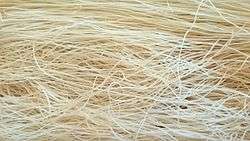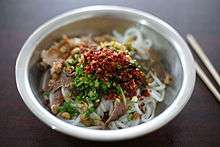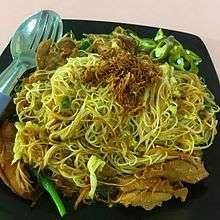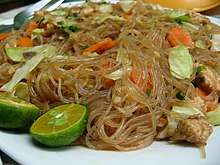Rice vermicelli
Rice vermicelli are a thin form of rice noodles.[1] They are sometimes referred to as rice noodles or rice sticks, but they should not be confused with cellophane noodles, a different Asian type of vermicelli made from mung bean starch or rice starch rather than rice grains itself.
 Strands of rice vermicelli | |
| Alternative names | Rice noodles, rice sticks |
|---|---|
| Type | Rice noodles |
| Place of origin | China |
| Region or state | East Asia, Indian subcontinent, and Southeast Asia |
| Main ingredients | Rice |
| Variations | Guilin mǐfěn |
| Rice vermicelli | |||||||||||||||||||||||||||||||
|---|---|---|---|---|---|---|---|---|---|---|---|---|---|---|---|---|---|---|---|---|---|---|---|---|---|---|---|---|---|---|---|
| Chinese name | |||||||||||||||||||||||||||||||
| Chinese | 米粉 | ||||||||||||||||||||||||||||||
| |||||||||||||||||||||||||||||||
| Vietnamese name | |||||||||||||||||||||||||||||||
| Vietnamese | bún | ||||||||||||||||||||||||||||||
| Thai name | |||||||||||||||||||||||||||||||
| Thai | เส้นหมี่ (sen mee) | ||||||||||||||||||||||||||||||
| Japanese name | |||||||||||||||||||||||||||||||
| Kana | ビーフン (bīfun) | ||||||||||||||||||||||||||||||
| Malay name | |||||||||||||||||||||||||||||||
| Malay | bihun | ||||||||||||||||||||||||||||||
| Filipino name | |||||||||||||||||||||||||||||||
| Tagalog | bihon | ||||||||||||||||||||||||||||||
| Tamil name | |||||||||||||||||||||||||||||||
| Tamil | சேவை (sevai) | ||||||||||||||||||||||||||||||
Presentation and varieties
Rice vermicelli are a part of several Asian cuisines, where they are often eaten as part of a soup dish, stir-fry, or salad. One particularly well-known, slightly thicker variety, called Guilin mǐfěn (桂林米粉), comes from the southern Chinese city of Guilin, where it is a breakfast staple.
Names
Rice vermicelli is widely known in Asia by cognates of Hokkien 米粉 (bí-hún, literally "rice vermicelli"). These include bīfun (Japan); bíjon or bihon (Philippines); bee hoon (Singapore); bihun (Malaysia and Indonesia); num banh chok (Cambodia); bún (Vietnam); and mee hoon (Southern Thailand)
Naming in Taiwan
Beginning July 1, 2014, Food and Drug Administration of Taiwan rules have been in effect that only products made of 100% rice can be labeled and sold as "米粉" in Taiwan, usually translated as "rice vermicelli" or "rice noodle". If the product contains starch or other kinds of grain powder as ingredients but is made of at least 50% rice, it is to be labeled as "調和米粉", meaning "blended rice vermicelli".[2] Products made of less than 50% rice cannot be labelled as rice vermicelli.[3]
Notable dishes
East Asia
Mainland China

- Cuisine of Yunnan and Guangxi: famous dishes including Crossing-the-bridge noodles, Guilin noodle and Luosifen (snail noodle). Rice noodle is also a main staple of ethnic Tai, Miao and Zhuang cuisine.
- Cantonese noodles: A large number of Cantonese dishes use this ingredient (called 米粉 maifun or rice in Cantonese). Usually the noodles are simmered in broth with other ingredients such as fish balls, beef balls, and/or fish slices.
- In Fujian and Teochew cuisine, rice vermicelli is a commonly used noodle and is served either in soup, stir-fried and dressed with a sauce, or even 'dry' (without soup) with added ingredients and condiments.
Hong Kong

Taiwan
- Taiwanese fried rice vermicelli is the dry, stir-fried local style (particularly known in the Hsinchu region). Its main ingredients include sliced pork, dried shrimp, and carrots.
- A Hsinchu specialty is to serve rice vermicelli 'dry' 乾 (gan, not in a soup) with mushroom and ground pork.
South Asia
India
- Sevai is a south Indian dish prepared in houses during festive occasions. It is had in different flavours like lemon sevai, tamarind sevai and coconut milk sevai.[6]
- Sawaeyaa is a dish made from semolina vermicelli cooked in milk sugar and dry nuts. It is eaten on Diwali, Eid, and other festive occasions in northern parts of India and Pakistan.
- "शेवया" (in Marathi Language) or "Shevaya" are served to groom and bride a day before their wedding called "Halad" / (हळद)" in some parts of Maharashtra.
- Paayasam is a South Indian sweet dish made from vermicelli, sago, sugar, spices and nuts and milk.
- Santhakai is a staple South Indian breakfast dish.
Southeast Asia
Cambodia
- Cha Mee Sor is a stir fry glass noodle dish that is a common dish in Cambodia. This dish is commonly made during Pchum Ben, Cambodia's ancestor day. This dish is made and taken to the temple and given to the ancestors along with other Cambodian dishes. This dish is sold on the streets of Cambodia and can be eaten any time during the year; mostly enjoyed at parties. Cha Mee Sor is made with vermicelli noodles and ground pork and sautéed with different asian sauces. Green onion can be used as garnish at the end.[7]
- Neorm is Cambodian cold noodle salad. Cabbage and vermicelli noodles are the main ingredient of this dish. It is usually served cold with chicken, pork, or shrimp whichever to your liking. A variety of vegetables and mints are added to the dish and is mixed with a homemade sweetened fish sauce. And topped with crushed peanuts. This dish can be served and eaten any time of the year. This dish can also be a very good vegetarian dish.[8][9][10]
- Nom Banh Chok is one of the Khmer popular local dishes. It is normally served in family gatherings or party. The typical Num Banh Chok is the one served with the so-called 'Samlor Proher soup' that is a greenish soup made of fish and pounded Khmer kreoung spices. Fresh vegetables including chopped cucumber, bean sprouts, etc. can be added to the dish in accordance with personal preference. Nom Banh Chok stall usually found in the fresh market and street vendors. Only a few shop available in Siem Reap like Sam Khmer Noodles is available with a proper seating area.[11][12]
Indonesia
- Bihun goreng, a Chinese Indonesian cuisine, stir fried rice vermicelli with sweet soy sauce
- Bihun kari, rice vermicelli mixed with curry.
- Bihun rebus or bihun kuah, also Chinese Indonesian cuisine rice vermicelli soup
- Lumpia and risoles, several types of spring rolls gorengan (fritters) use rice vermicelli and vegetables filling
- Mie bakso, bakso meatballs served with rice vermicelli soup
- Sup oyong, Chinese okra vegetable soup with rice vermicelli
- Soto, various types of soto (traditional Indonesian soup) often add rice vermicelli in it, such as Soto ayam
- Tekwan, a surimi type fish ball soup related to pempek from South Sumatra, also add rice vermicelli, mushroom, jicama and sedap malam flower
Malaysia
In Malaysia, the rice vermicelli can be called and found as Mihun, Mi hoon, Mee Hoon, Bihun, or Bee Hoon.
- Bihun Sup is a Malay style dish, mixed with spiced beef broth or chicken broth. Sometimes it comes with sambal kicap (pounded bird's eye chilli mixed with dark soy sauce) as a condiment.
- Bihun Kari mixed with curry, added with mung bean sprout, fried tofu and red chillies sambal.
- Bihun soto is in a yellow spicy chicken broth, served with chicken and potato cutlet.
- Hokkien mee throughout Malaysia varies considerably due to regional differences.
- Bihun Tom Yam is mixed with tom yam.
- Laksa Sarawak is mixed with a base of sambal belacan, sour tamarind, garlic, galangal, lemon grass and coconut milk, topped with omelette strips, chicken strips, prawns, fresh coriander and optionally lime. Ingredients such as bean sprouts, (sliced) fried tofu or other seafood are not traditional but are sometimes added.
- Mi Siam is a stir-fried style dish.
Myanmar
Philippines
- Pancit bihon (or pancit bihon guisado) is a general term for rice vermicelli dishes with a mixture of stir-fried shrimp, meat (usually pork or chicken) and various vegetables cooked in an adobo-style sauce with garlic, black pepper, soy sauce, patis (fish sauce), and other spices to taste. Usually topped with hard-boiled eggs and served with calamansi as a condiment.[13] It is also a common filling for the empanadas of the Tausūg people known as pastil.[14]
- Pancit choca (or pancit choca en su tinta) is a black seafood noodle dish made with squid ink and rice vermicelli from Cavite.[15]
- Pancit palabok is a rice vermicelli dish with shrimp sauce, topped with shrimp, pork, crushed chicharon, tinapa (smoked fish) flakes, hard-boiled eggs, scallions, and toasted garlic. Served with calamansi.[16]
- Pancit miki at bihon guisado is a combination of pancit bihon and pancit miki (egg noodles).[17]
- Pancit canton at bihon guisado is a combination of pancit bihon and pancit canton (wheat noodles).[18]
Singapore
- Kerabu bee hoon is a Nyonya-style rice vermicelli dish, mixed with herbs and other seasonings.
- Hokkien mee, commonly in Singapore, consists of rice vermicelli mixed with yellow noodles and fried with shrimp, sliced cuttlefish and pork bits. Hokkien mee throughout Malaysia varies considerably due to regional differences.
- Satay bee hoon is rice vermicelli served with spicy peanut satay sauce, common in Singapore.
- Seafood Bee Hoon is a rice vermicelli cooked with sauce and served in tasty seafood broth and seafood such as Lobster, crayfish, clams, scallops and prawns.
Vietnam
- Bánh hỏi
- Bún riêu is rice vermicelli in soup with crab meat.
- Bún bò Huế is rice vermicelli in soup with beef from Huế.
- Bún thịt nướng is a Vietnamese dish consisting of grilled pork (often shredded) and vermicelli noodles over a bed of greens (salad and sliced cucumber), herbs and bean sprouts. Also, it often includes a few chopped spring rolls, spring onions, and shrimp. It is commonly served with roasted peanuts on top and a small bowl of nước mắm pha (fish sauce with garlic, chilli, sugar, lime juice, water or coconut juice).
- Gỏi cuốn is rice vermicelli with pork, shrimp and herbs in a rice paper roll. It is served with nước chấm.
See also
References
- Lori Alden (2005). "Asian Rice Noodles". Retrieved November 4, 2011.
- www.fda.gov.tw. "市售包裝米粉絲產品標示規定". Retrieved 22 July 2016.
- www.fda.gov.tw. "食品標示法規手冊" (PDF). Retrieved 22 July 2016.
- "Singaporean Fried Rice Noodles". tastehongkong.com. 21 April 2010. Retrieved 13 August 2012.
- "How to make perfect Singapore noodles". theguardian.com. Guardian News and Media Limited. Retrieved 12 June 2014.
- "Indian Coconut Rice Noodles". Allrecipes.com.au.
- Larsen, Tevy. "Stir fry clear rice noodle (Char Mee Sur)". tevysfoodblog. blogspot. Retrieved 13 November 2019.
- Bolla, Sarah. "Cambodian Noodle Salad with Sweet Pepper Dressing". foodandwine.com. Retrieved 13 November 2019.
- "Fragrant Cambodian Noodle Salad". thekindcook.com. Retrieved 13 November 2019.
- "Fragrant Cambodian Noodle Salad". recipes.vegkit.com. Retrieved 13 November 2019.
- Mi, Yuen. "How to Make Cambodian Noodle: Num Banh Chok". awonderingfoodie.com. Retrieved 13 November 2019.
- Lina. "Khmer noodles: The story of num banh chok". movetocambodia.com. Retrieved 13 November 2019.
- "Pancit Bihon Guisado". Kawaling Pinoy. Retrieved 5 July 2019.
- "Pastil". Savor Filipino Foods. Retrieved 9 March 2020.
- Uy, Amy A. (24 February 2013). "Asiong's Carinderia: Why it still is the pride of Cavite City". GMA News Online. Retrieved 16 December 2018.
- "Pancit Palabok Recipe". Panlasang Pinoy. Retrieved 5 July 2019.
- "Filipino Pansit Miki at Bihon Guisado". Magluto.com. Retrieved 5 July 2019.
- "Pancit Canton at Bihon Recipe". Panlasang Pinoy. Retrieved 5 July 2019.

